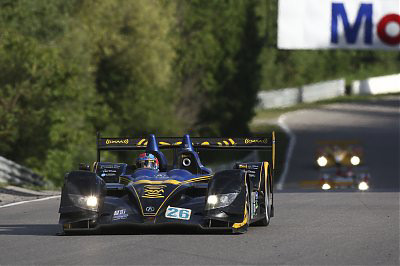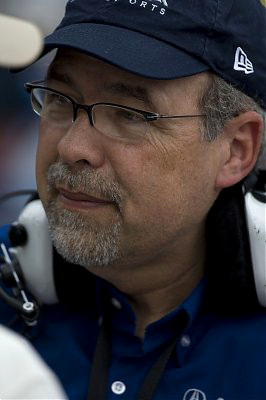The Way It Is/ Robert Clarke has prepared Honda Performance Development for his retirement
by Gordon Kirby Eleven days ago Honda announced Robert Clarke will retire on January 1st from his post as the head of Honda Performance Development and take up an advisory role until his ultimate retirement from Honda after twenty-seven years at the end of June. Clarke has run HPD in Santa Clarita, California since its inception in 1993. He was hired by American Honda's Tom Elliott to put HPD together and lead Honda's motorsports program in the United States and Clarke helped drive the company to four CART manufacturer championships, two Indy 500 wins and two IRL titles before Honda became the IRL's spec engine supplier two years ago.
Eleven days ago Honda announced Robert Clarke will retire on January 1st from his post as the head of Honda Performance Development and take up an advisory role until his ultimate retirement from Honda after twenty-seven years at the end of June. Clarke has run HPD in Santa Clarita, California since its inception in 1993. He was hired by American Honda's Tom Elliott to put HPD together and lead Honda's motorsports program in the United States and Clarke helped drive the company to four CART manufacturer championships, two Indy 500 wins and two IRL titles before Honda became the IRL's spec engine supplier two years ago.
This year, American Honda expanded into the ALMS series with an Acura-branded LMP2 program. The sports car program kicked-off with a storybook class win and second place overall in this year's Sebring 12 hours. Over the rest of the season the trio of Acura teams were comprehensively outpaced by the pair of well-developed Penske/Porsche Spyder LMP2 cars, but Clarke says the surprise performance by the Andretti-Green Acura team at Sebring this year was the highlight of his fifteen-year tenure as the boss of HPD.
"Sebring showcased the company's accumulated ability," Clarke commented. "Fifteen years of work was demonstrated at that event. All the years of developing the expertise within the company--the structures, the facility and procedures for doing things. In the early days we struggled to screw an engine together and now we're completely designing and manufacturing engines along with all the chassis stuff.
"So that was a pretty special moment. All that work came together and to have it showcased in such a grand way at such an historic event and beating the likes of Penske and Porsche was a great feeling for everyone involved with the project."
Clarke paused to reflect, then continued. "There have been many great moments. Our first championship at Laguna in '96 was very special, and we had the pleasure to work with many great drivers. You hate to single anyone out, but Jimmy Vasser brought us our first championship and Alex Zanardi was a tremendous driver and just a delightful person. But again, there were many great drivers--Gil de Ferran was an excellent test driver. And of course, Dario and Tony Kanaan. We've had a lot of very, very good drivers. One of the things I miss on the IRL side today is that there's no special relationship with our drivers because all of them have our engines."
Over the coming years, the ALMS sports car program with Acura will increasingly be the focus of American Honda's racing efforts. The plan for the Acura program was to race in the LMP2 class for two years before moving up to LMP1 in 2009 although that may change following the ALMS and Automobile Club de l'Ouest's decisions to introduce a new 'Evo' closed car in '09.

© LAT USA
This year's and next year's Acura LMP2 cars are based on Courage chassis but HPD will build its own cars for 2009. Clarke says HPD's infrastructure requires more development before the company can build its own cars.
"We have adequate space," he commented. "That's not an issue. It's more an understanding of what kind of equipment we would need to support that effort. We need to train the people required and develop an understanding of what kind of infrastructure is required to support the program long term from a head count point of view, as well as equipment, budget and trackside support. This not a short term project. This is something that's going to take five or six years to develop."
One of the reasons for Clarke's warm memories from Sebring this year was that it took a huge amount of effort just to make it to the ALMS season-opener. The first Acura development car underwent considerable re-engineering after HPD conducted wind tunnel and shaker rig tests on the Courage chassis.
"We had no experience with Courage and didn't know exactly what we were buying," Clarke observed. "But it looked like it had room for improvement which turned out to be a major understatement. There were some significant issues which needed to be addressed immediately. So the chassis development program we had planned as a season-long effort turned into basically a three-month chassis development program to have it ready for Sebring.
"It was such that through our full-scale wind tunnel and chassis stiffness testing we determined the car was not raceable. We made some major suspension upgrades and all-new bodywork before the thing ever hit the track. The chassis was way overweight and we were able to get a good chunk of weight out of it with the changes we made.
"Our objective before Sebring was to finish the race. We thought that was a challenge in itself. We never dreamed of winning. We went there really not understanding what the targets are. You work as hard as you possibly can and try to be as ready as you can be, and that's all we did. Based on the testing we had done up until then, including our twelve-hour test which was the best testing we had done, we had serious doubts that we would finish."
But as the season unfolded after the amazing Sebring dream, reality arrived. "I think we had some bad luck at St Pete, Long Beach and Houston," Clarke remarked. "I think we could have won all three of those races but some mistakes by our teams and drivers resulted in less than wins. We did have overall poles at Long Beach and Houston, which was an indication that we had the performance. But I think we let our guard down. We irritated Porsche a little and they stepped up their game, and by Salt Lake City they were well ahead of us and we never really caught up.

© LAT USA
The new Acura LMP2 car will be tested for the first time in December followed by a series of tests in January and February. Four new ARX01bs are being built and all three Acura teams will run the cars next year. Adrian Fernandez will switch from running a Lola this year and there's a chance that a fourth car will race next year.
The naturally-aspirated Acura V-8 engine is based on an old IRL design and is the first engine developed entirely by HPD. "The engine was really the strength of the program this year," Clarke observed. "We were pleasantly surprised. We had zero engine problems through the season which is quite remarkable, particularly with three teams. So because we had such good reliability I think you'll see us be a bit more risky this year and crank up the performance a bit. At the same time, we're trying to get weight out of the engine and the chassis."
The ALMS is adding twenty-five kilograms to the LMP2 weight minimum, up to 800 kgs for next year. "That'll help us, but Porsche will still be able to optimize where they put the ballast better than we can," Clarke said. "We can't get there with what we have at the moment. We looked at redoing the tub which would allow us to make some significant improvements to the suspension and the overall layout of the car. But looking at the impact it would have on our move to P1, we decided against it."
Clarke says it will be a few years, at least, before Acura races at Le Mans. "A number of factors are involved. Clearly the priority for American Honda is the ALMS series. They don't have a whole lot of interest in Le Mans, although for sure, winning Le Mans would have advertising value here in the United States. Honda Motor has a strong interest in Le Mans but they only want to go if we can showcase some unique Honda technology and our initial effort in P1 will be pretty conventional.
"The other element is the introduction of Acura into Europe and the international marketplace. Acura was introduced into China last year but the introduction into Japan has been delayed and at this point we're not exactly clear when it will be introduced into Japan and it's even less clear when it will be introduced in Europe. I think it's possible to race at Le Mans before Acura might arrive in Europe but there needs to be a clear understanding of when that will occur so it can all be communicated at the same time as part of the program."
The plan and contingency planning for Acura's sports car campaign is in place. Meanwhile, after a breather, check out this space on Thursday for the second part of this week's column in which Clarke offers some very frank comments about Honda's involvement in the IRL and discusses his hopes and frustrations regarding that series' future.
Auto Racing ~ Gordon Kirby
Copyright 2007 ~ All Rights Reserved
Copyright 2007 ~ All Rights Reserved
Top of Page